
LaSalle County is a county located within the Fox Valley and Illinois River Valley regions of the U.S. state of Illinois. As of the 2020 Census, it had a population of 109,658. Its county seat and largest city is Ottawa. LaSalle County is part of the Ottawa, IL Micropolitan Statistical Area of Northern Illinois.

Centralia is a city in Clinton, Jefferson, Marion, and Washington counties in the U.S. state of Illinois with the largest portion in Marion County. The city is the largest in three of the counties; Clinton, Marion, and Washington, but is not a county seat of any of them. The population was 12,182 as of the 2020 census, down from 13,032 in 2010.
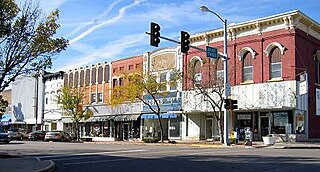
LaSalle or La Salle is a city in LaSalle County, Illinois, United States, located at the intersection of Interstates 39 and 80. It is part of the Ottawa, IL Micropolitan Statistical Area. Originally platted in 1837 over one square mile, the city's boundaries have grown to 12 sq mi (31 km2). City boundaries extend from the Illinois River and Illinois and Michigan Canal to a mile north of Interstate 80 and from the city of Peru on the west to the village of North Utica on the east. Starved Rock State Park is located approximately 5 mi (8 km) to the east. The population was 9,582 as of the 2020 census, down from 9,609 at the 2010 census. LaSalle and its twin city, Peru, make up the core of the Illinois Valley. Due to their combined dominance of the zinc processing industry in the early 1900s, they were collectively nicknamed "Zinc City."
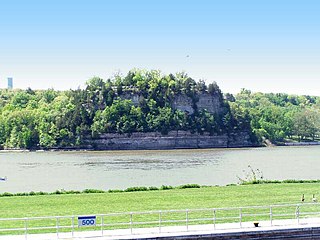
Starved Rock State Park is a state park in the U.S. state of Illinois, characterized by the many canyons within its 2,630 acres (1,064 ha). Located just southeast of the village of Utica, in Deer Park Township, LaSalle County, Illinois, along the south bank of the Illinois River, the park hosts over two million visitors annually, the most for any Illinois state park.
The Illinois Historic Preservation Division, formerly Illinois Historic Preservation Agency, is a governmental agency of the U.S. state of Illinois, and is a division of the Illinois Department of Natural Resources. It is tasked with the duty of maintaining State-owned historic sites, and maximizing their educational and recreational value to visitors or on-line users. In addition, it manages the process for applications within the state for additions to the National Register of Historic Places.

The Grand Village of the Illinois, also called Old Kaskaskia Village, is a site significant for being the best documented historic Native American village in the Illinois River valley. It was a large agricultural and trading village of Native Americans of the Illinois confederacy, located on the north bank of the Illinois River near the present town of Utica, Illinois. French explorers Louis Joliet and Father Jacques Marquette came across it in 1673. The Kaskaskia, a tribe of the Illiniwek people lived in the village. It grew rapidly after a French mission and fur trading post were established there in 1675, to a population of about 6,000 people in about 460 houses. Around 1691 the Kaskaskia and other Illiniwek moved further south, abandoning the site due to pressure from an Iroquois invasion from the northeast.

The Cahokia Courthouse State Historic Site is a reconstructed French-Canadian structure built about 1740 at what is now 107 Elm Street, Cahokia Heights, Illinois. At various times it has served as a house and as a courthouse. It is currently interpreted to resemble its appearance about 1800 as a frontier courthouse of the Northwest Territory. The courthouse was listed on the National Register of Historic Places on November 9, 1972.
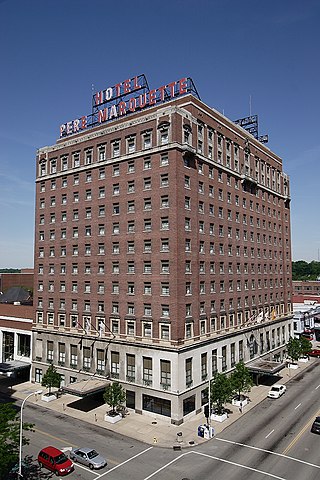
The Peoria Marriott Pere Marquette, is a historic 14-story hotel in downtown Peoria, Illinois, United States. Built in 1926, the building is Peoria's only surviving example of an upscale 1920s hotel. It was listed on the National Register of Historic Places in 1982.
Marshall and Fox was a United States architectural firm based in Chicago from 1905 to 1926. The principals, Benjamin H. Marshall and Charles E. Fox, designed a number of significant buildings of many types in Chicago and other cities, but they were best known for luxury hotels and apartment buildings.

The Big Bureau Creek is a 73-mile-long (117 km) tributary of the Illinois River in north central Illinois. It rises approximately 10 miles (16 km) north of Mendota and flows southwest into Bureau County, turning south at Princeton and then flowing east into the Illinois River floodplain. Among the creek's more notable features is the Red Covered Bridge, built in 1863, which passes over Big Bureau Creek and was once part of the Peoria Galena Trail. The bridge, located just north of Interstate 80, is listed on the National Register of Historic Places.
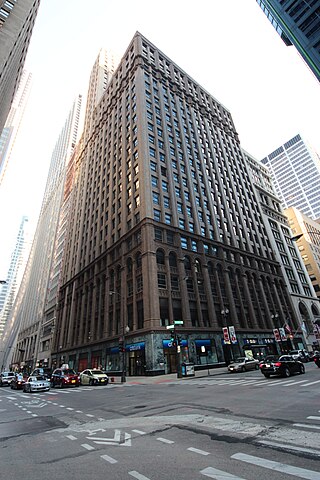
11 South LaSalle Street Building or Eleven South LaSalle Street Building is a Chicago Landmark building that is listed on the National Register of Historic Places and that is located at 11 South LaSalle Street in the Loop community area of Chicago, Illinois, United States. This address is located on the southeast corner of LaSalle and Madison Street in Cook County, Illinois, across the Madison Street from the One North LaSalle Building. The building sits on a site of a former Roanoke building that once served as a National Weather Service Weather Forecast official climate site and replaced Major Block 1 after the Great Chicago Fire. The current building has incorporated the frontage of other buildings east of the original site of Major Block 1.

The Chicago, Rock Island and Pacific Depot in Marseilles, Illinois is a historic train station built in 1917. It was in operation as a rail depot until 1974. The depot was added to the U.S. National Register of Historic Places in 1995.

This is a list of the National Register of Historic Places listings in LaSalle County, Illinois.

The La Salle Hotel was a historic hotel located on the northwest corner of La Salle Street and Madison Street in the Chicago Loop community area of Chicago, Illinois, United States. It was designed by Holabird & Roche and opened in 1909. After a major fire in 1946, the hotel was refurbished and reopened in 1947. It closed in 1976 and was demolished for construction of an office building.
Joseph F. Booton (1897-1983) was an American architect and painter.
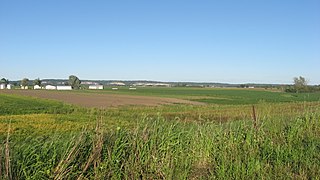
The Kolmer Site is an archaeological site in the far southwest of the U.S. state of Illinois. Located near Kaskaskia and Prairie du Rocher in western Randolph County, it lies at the site of an early historic Indian village from the French period. Because it occupies a critical chronological and cultural position, it has been given national recognition as a historic site.
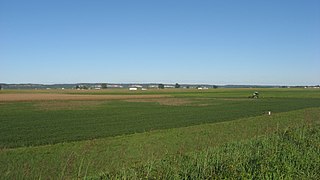
The French Colonial Historic District is a historic district that encompasses a major region of 18th-century French colonization in southwestern Illinois. The district is anchored by Fort de Chartres and Fort Kaskaskia, two important French settlements and military posts in what was then the Illinois Country. The Kaskaskia village site is also included within the district; it includes the Pierre Menard House, the only surviving building from Illinois' first state capital. Over a dozen French houses in Prairie du Rocher are also part of the district, including the poteaux-sur-sol Creole House and the 1735 Meilliere House. In addition to the French sites, the district also includes several Native American archaeological sites, such as the Modoc Rock Shelter, the Kolmer Site, the Waterman Site, and the Henke Site.

The Spring Valley House–Sulfur Springs Hotel is a historic former hotel located along Dee Bennett Road in rural Utica Township, LaSalle County, Illinois. Built circa 1849, the hotel is unusually large for a rural hotel of the area. The brick and limestone building, which features Greek Revival elements and vernacular stonework, is four stories tall and 63 by 42 feet in area. Its size is likely a result of it serving two different audiences; due to its proximity to the Illinois River and a major stagecoach line, it hosted travelers passing through the area, but it also functioned as a resort destination due to the area's hot springs. Three such springs are located on the site of the hotel, one of which has a spring house built over it. The opening of the Chicago and Rock Island Railroad through the area doomed the hotel, as stagecoach and river travel declined dramatically, and it closed after 1862.

The LaSalle Downtown Commercial District is a national historic district in downtown LaSalle, Illinois. The district encompasses 93 contributing buildings which historically formed the commercial and governmental center of LaSalle. Development in downtown LaSalle began with the completion of the Illinois and Michigan Canal in 1837 and the construction of railroads through the city in the 1850s; it continued through the mid-twentieth century. The district's commercial buildings represent many architectural styles, with popular styles of the late nineteenth century such as Italianate, Queen Anne, and Romanesque Revival being the most common. Significant government buildings include the LaSalle City Building and two post office buildings.
The Kaskaskia were an indigenous North American tribe of the Northeastern Woodlands.

















